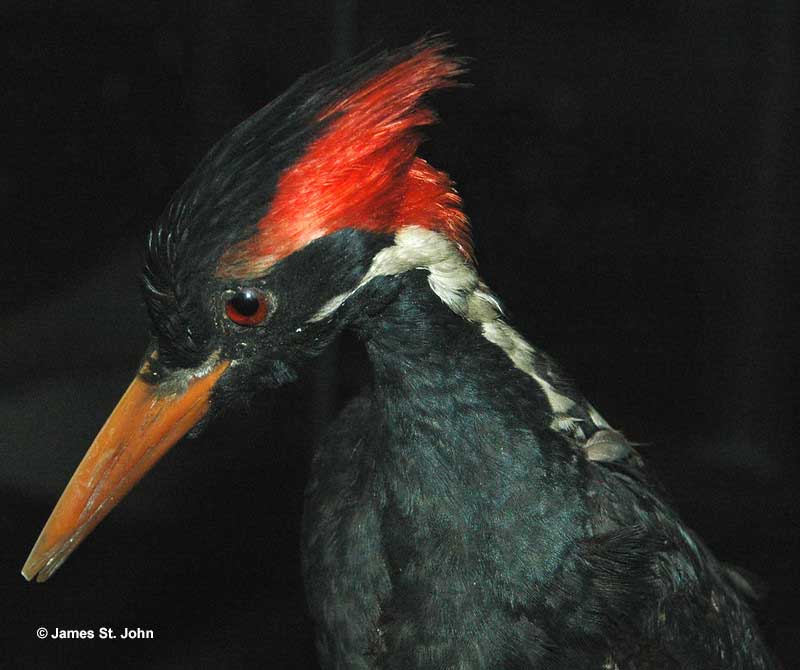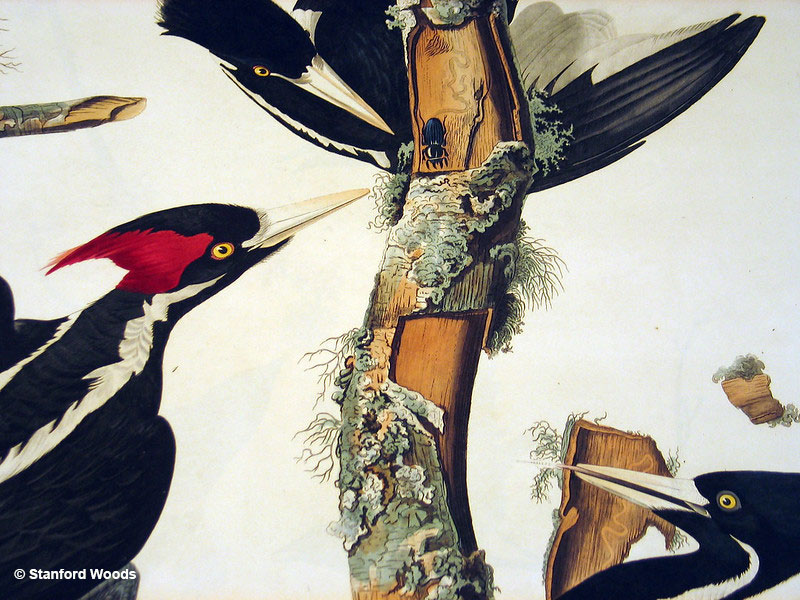Ivory-Billed Woodpecker is a species of woodpecker that was once found in the southeastern United States and Cuba. It is known for its striking black and white plumage and large size, with a length of up to 20 inches.
Unfortunately, the Ivory-Billed Woodpecker has been considered extinct since the 1940s due to habitat loss and hunting.
However, there have been occasional reports of sightings of the bird, leading to hope that small populations may still exist and efforts have been made to locate and repair their habitats.
On this page
Identification
The most distinctive feature of an Ivory-Billed Woodpecker is its glossy black and white plumage, with a large, ivory-colored bill that has a flattened tip.
The bird is mostly black but has a white line running down from its cheeks down the sides of its neck and continuing down its back. The wings and tail are also black, with white on the ends of the inner primary and the whole of the outer secondary feathers.
The males and females are slightly different. The male has a red crest on top of his head, which can be raised or lowered, and a red patch on the back of his head.
Ivory-Billed Woodpeckers’ size is one of their most outstanding characteristics. They grow up to 20 inches long and have a wingspan of 30 inches, making them one of the largest woodpeckers in North America.
Ivory-Billed Woodpecker’s call is quite unique. It is a loud and clear nasal kent that sounds like a trumpet. The bird can give it in single or two notes, often while searching for food. It could also make a fast double snap with its bill, with the second sound being quieter.
The bird’s flight is described as that of a duck – strong and direct. When flying in between trees, they did graceful and long glides.
Food
Ivory-Billed Woodpeckers were omnivores. Their diet consisted of insects, seeds, grains, nuts, and fruit.
Their preferred food of choice was large beetle larvae, particularly from the longhorn, jewel, and click beetle families.
They used their large, powerful bills to rip the bark off dead or dying trees, or less frequently dug holes into the wood in search of food. These insects could be found in abundance in areas where there were a lot of dead trees. That’s why you could see Ivory-Billed Woodpeckers foraging in recently burned or flooded areas.
The other half of Ivory-Billed Woodpeckers’ diet consisted of fruits and nuts, such as pecans, acorns, hackberries, grapes, poison ivy seeds, and hickory nuts.
Nesting and Eggs
Ivory-Billed Woodpeckers are known to nest 15-70 feet above the ground in dead or dying trees, or in a dead section of a living tree, typically under a branch. They choose one with wood soft enough to excavate, although not soft enough for predators to get through.
The male and female work together to excavate the nest hole, which could be as deep as 2 feet, with the nest hole itself being 4-5 inches wide and 5-6 inches tall.
The female Ivory-Billed Woodpecker usually lays 1 to 6 eggs, on average 2-3 per clutch, which are pure white in color. Both the male and female take turns incubating the eggs, which usually hatch after about 2 weeks.
The chicks are born blind and helpless and are fed by both parents. The young leave the nest after about 5 weeks. The nest is kept quite clean with the cleaning duties falling on the male.
Ivory-Billed Woodpeckers are known to be monogamous, and they typically built a new nest each year. The young birds remain with their parents for a long time after fledging which can be up to a year or longer, although they are able to forage on their own at three months old.
Current Situation
Ivory-Billed Woodpeckers were once found in the southeastern United States and Cuba. They inhabited forests with a lot of dead or dying trees for foraging and nesting, and with open canopies so they could fly freely. Ivory-Billed Woodpeckers were known to nest in pines, red maples, and bald cypresses.
They also frequented places where a recent disaster, such as a fire or flood had swept over because of the abundance of dead trees meant more food.
Unfortunately, due to human activities such as logging, land conversion, and hunting, these habitats have been greatly reduced. It is listed as critically endangered on the IUCN Red List of Threatened Species has listed Ivory-Billed Woodpecker as extinct.
Related: Extinct birds – what happened to them?
The last universally accepted Ivory-Billed Woodpecker sightings were in 1944 in Louisiana and although there are more recent claims, then they are not met with much belief, since they lack concrete hard proof, such as clear photos or recordings.
In 2005, it was announced that the bird had been rediscovered in Arkansas, although the four-second video of the bird in flight was so grainy that people were not convinced. In late 2021, the US Fish and Wildlife Service proposed that the bird should be officially declared extinct in the US. This proposal was met with resistance.
The latest paper called Multiple lines of evidence indicate survival of the Ivory-billed Woodpecker in Louisiana published in 2022, claims that the bird still exists in Louisiana. According to this, the Ivory-Billed Woodpecker was last sighted in December 2021.
The paper puts emphasis on the fact, that if we want the situation to improve, then we should help large and continuous bottomland forests exhibit old growth characteristics.
There have been no known Ivory-Billed Woodpecker sightings in 2023.
Facts
- Native Americans collected the bills of Ivory-Billed Woodpeckers because it symbolized successful warfare. Their bills were also actively traded across North America.
- Ivory-Billed Woodpecker has two subspecies, namely American Ivory-Billed Woodpecker and Cuban Ivory-Billed Woodpecker. They look similar but have some variations in plumage. The Cuban variant is slightly smaller, its white dorsal strips extend to the bill and the red crest feathers are slightly longer than the black ones.
- Ivory-Billed Woodpecker was so impressive in size that apparently, people who saw it exclaimed “Lord, God!”, earning itself the nickname “Lord God Bird”.
Since they are probably extinct and haven’t been seen in decades, it is difficult to say how long they lived, but earlier reports suggest that they could live 15-20 years old.
Similar Species
There is really only one other woodpecker species quite similar to Ivory-Billed Woodpeckers. If you think you have seen an Ivory-Billed Woodpecker, you should observe more closely and make sure that it’s not a Pileated Woodpecker instead.

© Alan D. Wilson
Pileated Woodpecker – These birds inhabit roughly the same habitats, behave similarly and have the same general body shape.
Pileated Woodpeckers are slightly smaller than Ivory-Billed Woodpeckers, have a smaller dark or silvery bill, and have more black in their plumage.
A male Pileated Woodpecker has a red horizontal stripe on its cheeks and more white on its head and throat. A perched Pileated Woodpecker has an all-black back and wings, as opposed to the white Ivory-Billed Woodpeckers display.
Related: Types of Woodpeckers in North America
Frequently Asked Questions
What killed off Ivory-Billed Woodpeckers?
Ivory-Billed Woodpeckers were mainly killed off by habitat destruction but also hunting since at some point their bills were traded all across the United States.
Has an Ivory-Billed Woodpecker been found?
An Ivory-Billed Woodpecker is claimed to have been found in eastern Arkansas in 2004 and also in Louisiana in 2021. These have not been official sightings and have been met with criticism.
When was the last sighting of an Ivory-Billed Woodpecker?
The last official sighting of an American Ivory-Billed Woodpecker was in 1944 in Louisiana and the last sighting of the Cuban subspecies occurred in 1987. There have been some reports in more recent times but they are rare and often grainy footage from far away or just eyewitness accounts.


